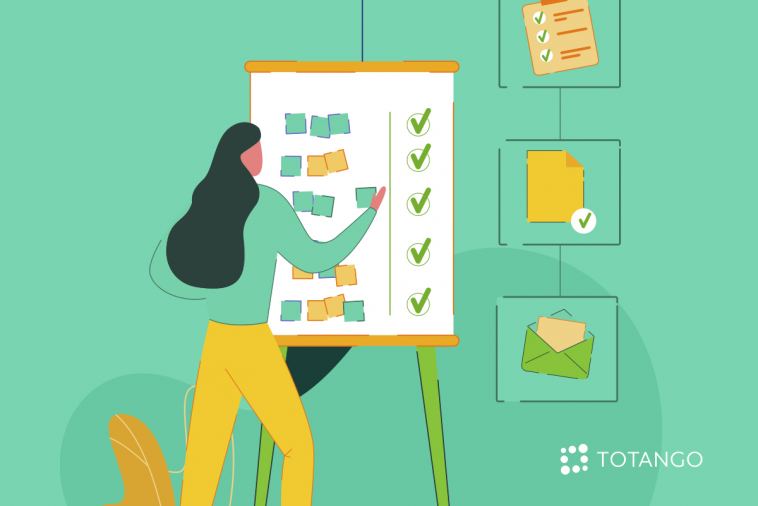- Like
- SHARE
- Digg
- Del
- Tumblr
- VKontakte
- Flattr
- Buffer
- Love This
- Save
- Odnoklassniki
- Meneame
- Blogger
- Amazon
- Yahoo Mail
- Gmail
- AOL
- Newsvine
- HackerNews
- Evernote
- MySpace
- Mail.ru
- Viadeo
- Line
- Comments
- Yummly
- SMS
- Viber
- Telegram
- JOIN
- Skype
- Facebook Messenger
- Kakao
- LiveJournal
- Yammer
- Edgar
- Fintel
- Mix
- Instapaper
- Copy Link
Customer success plans provide you with a powerful tool to help clients achieve their goals. With your product, they feel more satisfied with your brand, positioning your own business for success as well. Follow our simple three-step strategy for developing winning customer success plans:
- Agree on mutual goals with your customer
- Develop an action plan
- Monitor progress
Here are some tips on how to put these steps into practice and become a success partner for your customers.
What Is a Customer Success Plan?
Customer success plans are proposals that document your clients’ goals and how you will help achieve them. Their key components include:
- A list of objectives mutually agreed upon between you and your customer
- An action plan outlining concrete steps you and your customer will take to achieve their goals
- A set of key performance indicators and benchmarks to track and measure client progress towards goals
- A feedback system for incorporating data and client input in order to make strategic adjustments and improvements
Note that a detailed customer success plan may not be equally suitable for all your clients. A success plan is best suited for customers who require a high degree of interaction and support from you to achieve their goals.
While a customer success plan can be deployed manually, you can increase your plan’s efficiency and effectiveness by selecting the right customer success software. Customer success software provides a digital interface that you and your customers can use to easily align, document, and track success goals and progress. A distinguishing benefit of customer success software is that it empowers you and your customer to share updates and view results in real-time. This stands in contrast to plans shared via email or in a spreadsheet, where it becomes difficult to tie these outcomes to customer accounts.
How Do You Use a Customer Success Plan?
Putting a customer success plan into action itself requires careful planning. Here is a simple three-step approach to effective success planning.
1. Agree on Mutual Goals with Your Customer
For your plan to succeed, your customer must be committed to the outcome. Lay a foundation for a winning success plan by reaching an agreement with your customer about which goals you will help them achieve. Use discovery questions to help your customer identify their current and long-term business goals, prioritize them, and select which goals to pursue now.
To measure your customers’ progress towards their objectives, goals should be defined in terms of measurable key performance indicators and benchmarks. For instance, let’s say you sell an app designed to improve customer service performance, and it currently takes your customer an average of five minutes to respond to live chat support tickets, a KPI known as First Response Time(FRT). You and your customer might set a goal of reducing FRT for live chat support to less than two minutes.
You could then define four minutes and three minutes as benchmarks along your customer’s path to their goal. You and your customer might agree that each of these benchmarks should be reached within 90 days, with the goal of two minutes being reached within 120 days.
In a similar way, you could develop goals related to decreasing customer onboarding time, increasing adoption of a specific feature, improving customer satisfaction, preventing churn, or any number of other objectives. In addition to making progress towards goals easier to track and measure, this approach sets clear expectations for your customer and provides transparency. It also provides quantifiable, objective documentation of the value you provide your customer, which can promote higher customer satisfaction and retention.
2. Develop an Action Plan
Once you and your customer have agreed upon some mutual goals, the next step is to develop an action plan. Your plan should specify what steps your customer will take with your support in order to achieve the goals you have established.
For example, returning to our customer service performance example, if your customer’s goal is to reduce First Response Time, action steps might include:
- Monitoring First Response Time for performance
- Creating a knowledge base for their customers’ top 100 FAQs in order to facilitate automated chatbot support
- Defining procedures for determining which chatbot inquiries should be routed to live agents
- Developing a formula to estimate whether any additional agents need to be hired to meet first response time goals
You can make your action plan as general or detailed as you and your customer prefer. The more detailed your plan, the more likely a successful outcome.
Your plan should specify how your product or service will support the actions your customer takes. It should also indicate who on your customer’s team is responsible for specific tasks. Implement an action plan that sets a definitive timeline so the customer knows when a project is due and have a plan in place in case the project goes awry. The chain of command should be set in advance so it’s easier to get the client’s account back on track. This assigns ownership of responsibility and facilitates communication and collaborative workflow. It also allows you to document the actions you take to provide value to your customer.
3. Track Progress
Successful implementation of your action plan depends on proactive progress monitoring. Track client progress by using automated alerts. For best results, use digital tools to track progress in real-time, and set up a regular reporting and review routine to share and discuss progress with your customer.
Use Customer Success Plans to Achieve Winning Outcomes for You and Your Clients
A customer success plan lays out a map for how you will help your clients achieve their goals, pointing towards profitable outcomes for both your customers and your business. You can create a winning success plan by helping your customers establish measurable goals, develop an action plan, track progress, and collaborate in real-time.
Automating alerts for next steps can increase the efficiency of your action plan and generate more consistent results for your customers. Totango’s Spark platform is specifically built to support customer success plans and make it easy for you to help your customers achieve their goals. Register to see a live demo or try Totango Success Plans for free to see how easy it is to help your customers achieve their goals.



